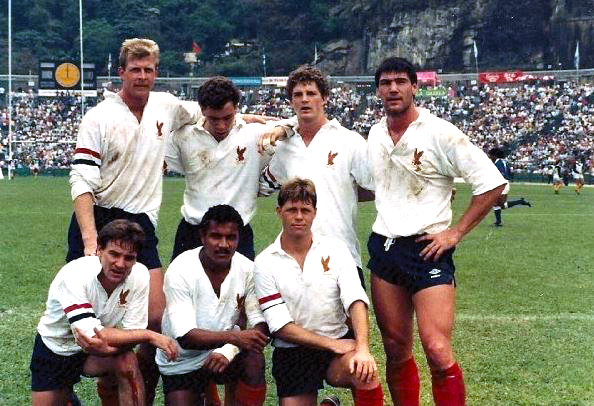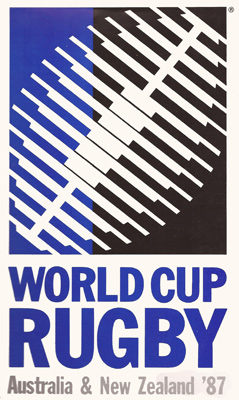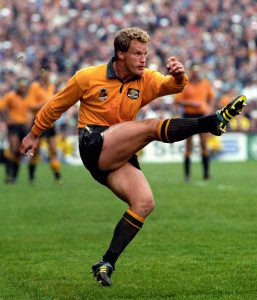
 In preparation for the 2015 Rugby World Cup, Rugby Rain Man Collective member Ryan Day will provide a match review and analysis of all the Rugby World Cup games in USA Rugby history.
In preparation for the 2015 Rugby World Cup, Rugby Rain Man Collective member Ryan Day will provide a match review and analysis of all the Rugby World Cup games in USA Rugby history.
FT. WAYNE, IN –In their second match in World Cup history, the Americans took on co-hosts Australia. Both teams came in off a win as Australia defeated England 19-6. The Eagles made a number of changes resting some key players for England, seeing it as more winnable.
Eagles and Wallabies start off the game doing some kicking back and forth for territory with a couple scrums in the middle (scrums went so much faster and fluid back then). A mis-kick by Eagle fullback Ray Nelson gives good field position to the Wallabies, and, off the lineout, a penalty against the Eagles due to Eagle flanker Steve Finkel not rolling away. Wallaby fly half Michael Lynagh easily kicks the penalty to give Australia the early 3-0 lead.
Later deep in their end, Lynagh boots a kick downfield on the touch line that Nelson is able to catch but still falls into touch. From the resulting lineout, the ball makes its way to Australian wing David Campese. The commentator tells us he has 22 tries, two away from the then international record of 24 by Scot Ian Smith that played from 1924-33. Campese does a great chip kick behind the Eagles defense that Eagle wing Gary Hein catches and runs into touch to give the Wallabies a lineout at the 5-meter line. The resulting lineout gets fumbled around a bit and the Eagles are able to touch down in the tryzone. However, the Wallabies push at will against the Eagle scrum, scrum collapses, and referee Brian Anderson immediately awards a penalty try. Commentators say it was a bit of a harsh call as the Eagle scrum was just destroyed instead of intentionally collapsing, which isn’t much better.

Both teams trade possession back and forth via kicking with a couple good linebreaks from the Aussies mixed in. The Wallabies play intelligent rugby based on kicking for territory. The Eagles for their part are playing much more disciplined than they did against Japan. At one point they are in Australian territory and able to work some phases together, and the Ballymore crowd cheers the American aggression.
Then, the Wallabies forgo a possible penalty kick to kick an up-and-under in front of the posts. The Eagles are able to get the ball but Eagle fly half Horton makes a poor clearance. Gary Lambert comes on to replace Eagle lock Bill Shiflet due to hand injury. There were no substitutes against Japan, so Lambert is the first-ever Eagle substitute at the World Cup. On the ensuing lineout, the Aussies maul it to just short of the try line. Anderson calls a 5-meter scrum and the Wallabies power the scrum again. Aussie scrum half Smith then passes to Campese who passes back to Smith after Smith loops and he’s able to score near the touch line in an all-around sweet play. Lynagh makes the kick from the sideline, Australia 15-0.

Off an Australian lineout near midfield the Eagles do their best work so far of the day. Smith gets the ball, fumbles it a bit, and throws the ball into the intercepting hands of Lambert. The ball swings wide and through the hands of 7 Eagles until Anderson calls a penalty against the Wallabies for laying over the ball. Crowd cheers the effort. Nelson takes his first kick for the day and draws the Eagles to within 12. The commentator lets us know that Nelson is from Glasgow and was once British junior 400 meters champion, so alas, our great kicker was produced elsewhere.
Another injury forces Eagle scrum half Dave Dickson to leave the game and in his place comes Mike Saunders. Only two substitutes at this time were allowed under test match rules and they were both used in the first half. After a scrum, the ball goes out to Campese who again chips over the American defense, Saunders is unable to gain possession of the ball, Campese recovers, and throws outside to Wallaby captain center Andrew Slack. Slack runs around Eagle winger Gary Hein who gives Slack a high tackle that would likely be a yellow card today as Slack touches down for the try. Lynagh continues his perfect kicking to make it 21-3.
Grinding away territory inside the Eagles 22, Wallaby lock Coker throws a poor pass that is intercepted by Eagle center Roy Helu. Eagles on the counterattack are able to run to the other end of the field. Some good desperate defense from Lynagh saves an Eagle try stealing a pass from Saunders and clearing. Halftime comes and the studio analysis says the Australians aren’t looking like potential world champions.
Play restarts, and after stealing an Eagle lineout, the ball falls to Wallaby hooker Tom Lawton, who grounds the ball in the tryzone but Anderson correctly rules it was a double movement. After the Eagles clear, Aussie center Matthew Burke picks holes through the Eagle defense and dishes to fullback Andrew Leeds who scores the try. Lynagh misses his first kick of the day from near the touch line. They then show Eagles coach Ron Mayes in the crowd, who looks a little like Chevy Chase. The holes are really opening in the Eagles defense now, as Campese with another adventurous kick is almost able to make a try out of it but just kicks beyond his fingers’ grasp and knocks on.
Saunders for the U.S. chips to the try line off a scrum at the Wallaby 22, and the kick just stops at the try line. Eagle wing Kevin Higgins picks it up and the ref calls him held up. The Eagle scrum does the best they can, and the Eagle backs swing the ball wide and Nelson scores the try. Nelson converts to stay at 100% kicking for the tournament. 25-9 Australia.
A fantastic individual try is then scored by Australian inside center Brett Papworth. Papworth jukes both Eagle centers to make them miss on tackles and dummies Nelson on a fake pass to score the try. Lynagh converts. Eagle defense notably tiring and the match is getting more and more one-way traffic at the Eagles’ end of the field. Wallabies almost score another try but their hooker Lawton gets white line fever and gives away the penalty after being isolated. After the Eagles do some enterprising play to move to midfield, the ball is turned over and after a long Papworth run where he jukes some more Eagles, he passes to Campese who touches the ball down to score for Australia’s sixth try and he is now one off the try record. Lynagh goes a little left on the conversion.
After the commentators congratulate Anderson on calling the Eagles offsides finally, the Aussies get to the try line forcing Nelson to clearance kick from the tryzone. From the ensuing lineout, the Wallabies off broken play are able to score with Codey underneath the posts. A couple minutes later off an Eagle scrum near the touch line, Eagle fly half Dave Horton from outside the 22 kicks a wonderful drop goal out of nowhere. Another few minutes and the ball flies through the Aussie backs to Australian #8 Steve Tuynman and the try is only saved by Eagle wing Gary Hein going in low and hard in a hit on Tuynman who knocks on in the try zone. Commentators remark on Hein’s gridiron background with that tackle. A couple more goalline defensive stands are made by the Eagles, partly due to good defense and partly due to Australian mistakes, but the Aussie backs move the ball at will. At full time, Leeds carves a hole through the American defense and scores under the posts. Lynagh converts followed by full time whistle.
USA – Australia – May 31, 1987 – Ballymore – Brisbane, Australia
USA: 1. Butch Horwath, 2. Pat Johnson, 3. Fred Paoli (capt.), 4. Kevin Swords, 5. Bill Shiflet, 6. Tony Ridnell, 7. Steve Finkel, 8. Brian Vizard, 9. Dave Dickson, 10. Dave Horton, 11. Gary Hein, 12. Tommy Vinick, 13. Roy Helu, 14. Kevin Higgins, 15. Ray Nelson, Substitutes: 18. Mike Saunders , 19. Gary Lambert
Australia: 1. Cameron Lillicrap, 2. Tom Lawton, 3. Andy McIntyre, 4. Troy Coker, 5. Bill Campbell, 6. David Codey, 7. Jeff Miller, 8. Steve Tuynman, 9. Brian Smith, 10. Michael Lynagh, 11. Matthew Burke, 12. Brett Papworth, 13. Andrew Slack (capt.), 14. David Campese, 15. Andrew Leeds
Australia–47 (21)
Tries: Penalty try, Smith, Slack, Leeds (2), Papworth, Campese, Codey
Conversions: Lynagh (6/8)
Penalty: Lynagh (1/1)
USA–12 (3)
Try: Nelson
Conversion: Nelson (1/1)
Penalty: Nelson (1/1)
Drop Goal: Horton (1/1)
My Man of the Match: Michael Lynagh, Australia
Well, that’s Lesson 2. Thanks for reading and feel free to comment below. Also, please look for and “Like” our Facebook Rugby Wrap Up Pageand follow us on Twitter@: RugbyWrapUp,Junoi

